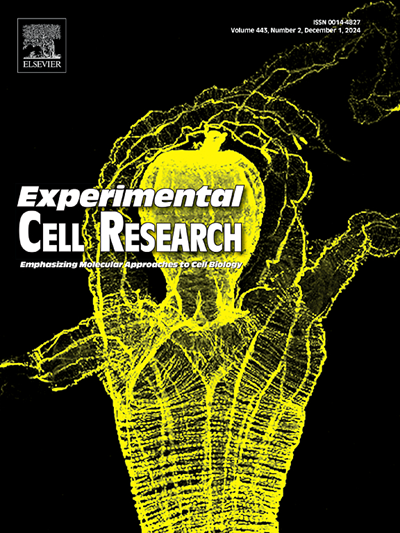Has_circ_0002360通过增强异质核核糖核蛋白A1的稳定性来促进免疫逃避,从而推动非小细胞肺癌的恶性进展。
IF 3.3
3区 生物学
Q3 CELL BIOLOGY
引用次数: 0
摘要
非小细胞肺癌(NSCLC)具有复杂的分子畸变,包括环状核糖核酸(circRNA)的不同表达。本研究旨在评估 hsa_circ_0002360 的表达模式及其在 NSCLC 中作为致癌因子的潜在作用。我们使用 R 软件分析了两个 GEO 数据集(GSE112214 和 GSE158695),以确定差异表达的 circRNA。与对照组相比,定量反转录 PCR(qRT-PCR)评估了 hsa_circ_0002360 在 NSCLC 组织和细胞系中的表达。我们使用 siRNA 和过表达载体来调节 A549 细胞中 hsa_circ_0002360 的水平,然后用实验来评估细胞的增殖、迁移、侵袭、凋亡和上皮-间质转化(EMT)。利用 RNA-pull down 和 RIP 试验研究了与 RNA 结合蛋白(特别是 HNRNPA1)的相互作用。在 GEO 数据集 GSE112214 和 GSE158695 中,发现 hsa_circ_0002360 在 NSCLC 中显著过表达,qRT-PCR 分析表明与对照组相比,hsa_circ_0002360 在 NSCLC 组织和细胞系中的水平更高。功能测试表明,在 A549 细胞中敲除 hsa_circ_0002360 会减少细胞的增殖、迁移和侵袭,改变上皮-间质转化标志物的表达,同时诱导细胞凋亡,这表明它具有致癌作用。相反,过表达会促进肿瘤特征,体内异种移植模型显示肿瘤生长增加也证实了这一点。通过 RNA 拔除和 RIP 试验证明,Hsa_circ_0002360 与 HNRNPA1 相互作用,这表明它参与了促进 NSCLC 进展的调控途径。hsa_circ_0002360 在 NSCLC 中是一种癌基因,通过调控细胞生长、凋亡和 EMT 过程促进肿瘤进展和转移。hsa_circ_0002360与HNRNPA1之间的相互作用提示了circRNA介导的NSCLC病理学调节的新机制,为治疗干预提供了潜在靶点。本文章由计算机程序翻译,如有差异,请以英文原文为准。
Has_circ_0002360 facilitates immune evasion by enhancing heterogeneous nuclear ribonucleoprotein A1 stability, thereby promoting malignant progression in non-small cell lung cancer
Non-small cell lung cancer (NSCLC) is marked by complex molecular aberrations including differential expression of circular RNAs (circRNAs). hsa_circ_0002360, a circRNA, has been identified as overexpressed in NSCLC. This study aimed to evaluate the expression patterns of hsa_circ_0002360 and its potential role as an oncogenic factor in NSCLC. We analyzed two GEO datasets (GSE112214 and GSE158695) using R software to identify differentially expressed circRNAs. Quantitative reverse transcription PCR (qRT-PCR) assessed the expression of hsa_circ_0002360 in NSCLC tissues and cell lines compared to controls. We used siRNA and overexpression vectors to modulate hsa_circ_0002360 levels in A549 cells, followed by assays to assess proliferation, migration, invasion, apoptosis, and epithelial-mesenchymal transition (EMT). Interactions with RNA-binding proteins, specifically HNRNPA1, were investigated using RNA-pull down and RIP assays. In GEO datasets GSE112214 and GSE158695, hsa_circ_0002360 was identified as significantly overexpressed in NSCLC, a finding supported by qRT-PCR analyses showing higher levels in NSCLC tissues and cell lines compared to controls. Functional assays demonstrated that knockdown of hsa_circ_0002360 in A549 cells decreased proliferation, migration, invasion, and altered epithelial-mesenchymal transition marker expression, while inducing apoptosis, suggesting its oncogenic role. Conversely, overexpression promoted tumor characteristics, corroborated by in vivo xenograft models showing increased tumor growth. Hsa_circ_0002360's interaction with HNRNPA1, evidenced through RNA-pull down and RIP assays, implicates it in regulatory pathways that enhance NSCLC progression. This expression was also correlated with advanced TNM stages and metastasis, highlighting its potential as a therapeutic target. hsa_circ_0002360 acts as an oncogene in NSCLC, promoting tumor progression and metastasis through regulation of cell growth, apoptosis, and EMT processes. The interaction between hsa_circ_0002360 and HNRNPA1 suggests a novel mechanism of circRNA-mediated modulation of NSCLC pathology, providing potential targets for therapeutic intervention.
求助全文
通过发布文献求助,成功后即可免费获取论文全文。
去求助
来源期刊

Experimental cell research
医学-细胞生物学
CiteScore
7.20
自引率
0.00%
发文量
295
审稿时长
30 days
期刊介绍:
Our scope includes but is not limited to areas such as: Chromosome biology; Chromatin and epigenetics; DNA repair; Gene regulation; Nuclear import-export; RNA processing; Non-coding RNAs; Organelle biology; The cytoskeleton; Intracellular trafficking; Cell-cell and cell-matrix interactions; Cell motility and migration; Cell proliferation; Cellular differentiation; Signal transduction; Programmed cell death.
 求助内容:
求助内容: 应助结果提醒方式:
应助结果提醒方式:


